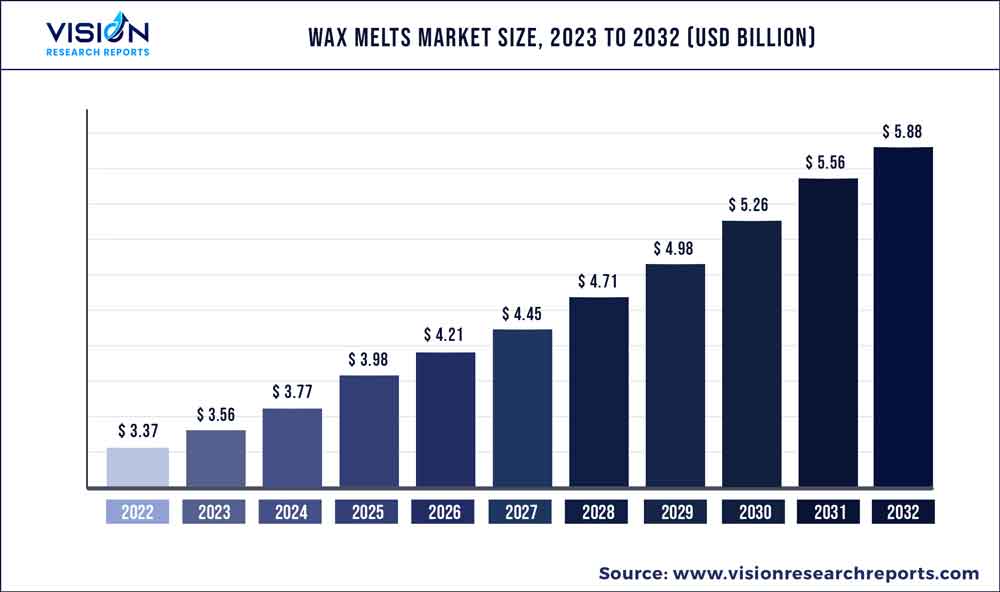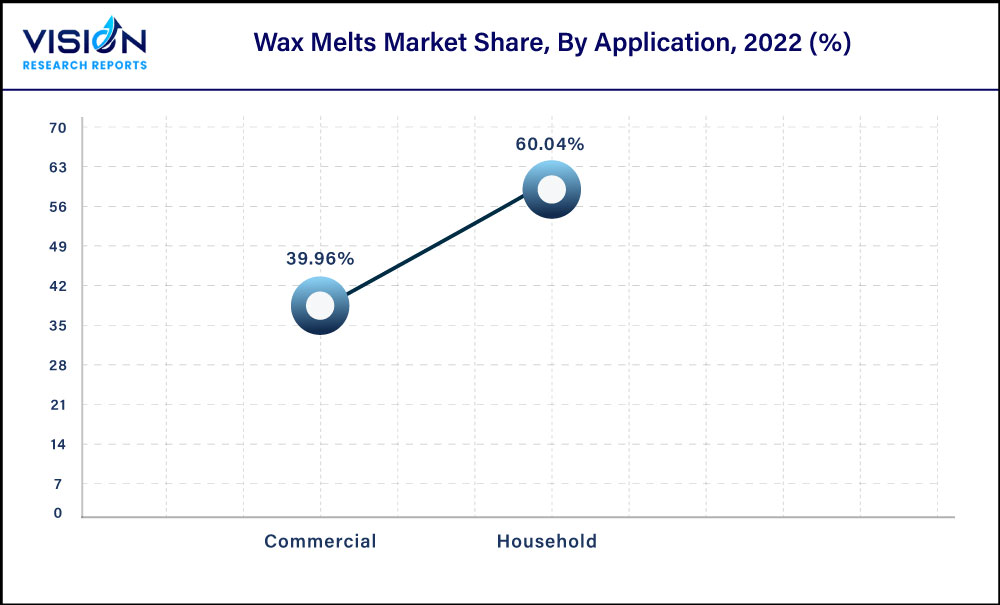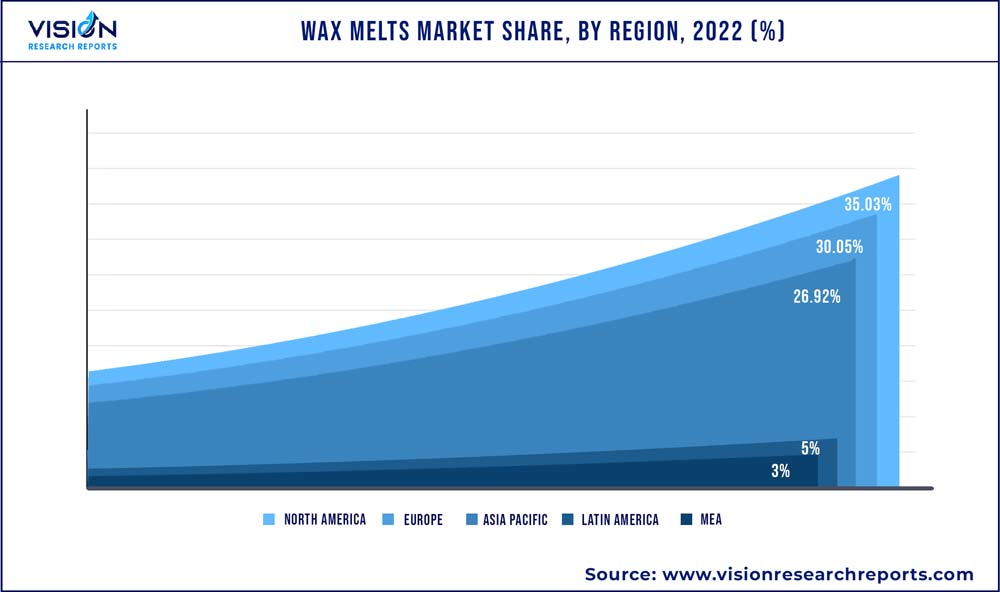The global wax melts market was valued at USD 3.37 billion in 2022 and it is predicted to surpass around USD 5.88 billion by 2032 with a CAGR of 5.73% from 2023 to 2032. The wax melts market in the United States was accounted for USD 846.6 million in 2022.

Key Pointers
Report Scope of the Wax Melts Market
| Report Coverage | Details |
| Revenue Share of North America in 2022 | 35.03% |
| CAGR of Asia Pacific from 2023 to 2032 | 6.54% |
| Revenue Forecast by 2032 | USD 5.88 billion |
| Growth Rate from 2023 to 2032 | CAGR of 5.73% |
| Base Year | 2022 |
| Forecast Period | 2023 to 2032 |
| Market Analysis (Terms Used) | Value (US$ Million/Billion) or (Volume/Units) |
| Companies Covered | East Coast Candles; The Yankee Candle Company; Michaels Stores, Inc.; Scentsy, Inc.; Bridgewater Candle Company; Bramble Bay Candle Co.; AFFCO Holdings; Candles by Victoria; C. Johnson & Sons Inc.; and NEST Fragrances, LLC. |
The non-flammable property of wax melts can play a pivotal role in driving their market growth by appealing to safety-conscious consumers. By positioning wax melts as a safe, versatile, and practical alternative to traditional candles, businesses can expand their customer base and drive revenue growth. The safety feature can help build trust and loyalty among customers, resulting in positive brand perception and increased market share.
The pandemic has led to several changes in consumer behavior and their purchasing patterns for home décor products including increased demand for home fragrance products such as wax melts. According to an article published by The Vogue in January 2022, 85% of the people across the globe used home fragrances more often during the pandemic in 2020 leading the candles and wax melts industry to experience a surge in sales of those products. Additionally, the pandemic has put a renewed emphasis on health and well-being, and this has extended to the home fragrance market as well. Consumers are increasingly looking for natural and eco-friendly wax melts that are free from harmful chemicals.
With more people spending time at home, DIY and personalization have become popular trends. Consumers are now looking for ways to make their wax melts at home or purchase customizable wax melts with their preferred scents and designs. Furthermore, it has also led to an increased interest in seasonal scents, with consumers looking for wax melts that evoke a mental state of warmth and comfort during the colder months.
According to the U.S. Fire Administration in 2022, 42 candle-related fires are reported daily on average in the U.S. The increase in fire accidents related to traditional candles has raised consumer awareness about the potential safety hazards associated with these products. This trend presents a unique opportunity for businesses to promote their wax melt products as a safer alternative to traditional candles.
The key player in the wax melts industry position wax melts as a safe and convenient option for home fragrance by highlighting their non-flammable nature and ease of use. For instance, Fontana Candle Co. based in California, U.S. offers wax melts with different ingredient variants such as beeswax, coconut oils, and pure essential oils. The company sells products that are all-natural, non-flammable, and MADE SAFE certified.
The Canada wax melts market is expected to expand significantly as a result of the wide range of fragrances available to buyers. Wax melts can be used in various ways for home decor; this versatility will help them flourish. Along with their aesthetic attributes, these products create a relaxed ambiance, reducing stress and promoting well-being. Moreover, collaborations and expansions are increasing as companies strive to strengthen their market position.
For instance, in June 2022, French luxury candle and wax melt brand Diptyque announced its first store in the Canadian market in Toronto’s Yorkdale Shopping Center. It is a part of the direct-to-consumer expansion of the brand. Diptyque will also join other nearby beauty brands, including Aesop and a large Sephora store.
Product Insights
The paraffin wax melts segment dominated the market with a revenue share of around 30.03% in 2022. Paraffin wax melts are a popular choice among consumers due to their affordability and widespread availability. This type of wax is commonly used in the candle industry as it can hold a large amount of fragrance and is suitable for use in various types of wax melt warmers. To cater to the rising demand from consumers, market players are concentrating on integrating paraffin wax with innovative scents that appeal to their target audiences. Companies have also raised their R&D expenditure. In January 2022, The Yankee Candle Company, Inc. launched a single wax melt, a medium square jar with three wicks, and a big square jar with two wicks that are all available in the Well Living Collection. Such initiatives are expected to help companies boost their product visibility and boost their revenues.
The palm wax melts segment is projected to register a CAGR of 7.04% from 2023 to 2032. Palm wax candles are made of hydrogenated palm oil. These candles are increasingly used as an alternative to industrially produced wax. Palm wax has a similar burn quality as that paraffin wax but is comparatively less toxic to the environment. Non-profit associations such as the Roundtable on Sustainable Palm Oil (RSPO) help in regulating and sourcing palm oil from ethical farms. According to the RSPO in 2022, approximately 3.51 million-hectare production areas are certified globally. Palm wax melts are known for their ability to hold a significant amount of fragrance oil, which makes them a great choice for creating unique and exotic scents. There is a growing trend toward using more complex fragrance blends, including floral, herbal, and fruity notes.
Pack Insights
The multi pack wax melts segment dominated the market with revenue share of around 50.04% in 2022. The demand for multi-pack wax melts for aromatherapy has been increasing in recent years, particularly as more consumers seek to create relaxing and calming environments in their homes and workplaces. Offering multi-pack wax melt can help key players generate more revenue by encouraging customers to purchase in bulk. This can be especially effective when paired with promotional discounts or other incentives to drive sales aiding the wax melts market.
The single pack wax melt segment is projected to expand with a CAGR of 11.92% over the forecast period. Consumers may opt to purchase a single wax melt, as it is cost-effective for the consumer to purchase a single wax melt rather than investing in a larger quantity. Additionally, consumers who prefer to wax melt try out a new scent or brand before committing to a larger purchase, and buying a single wax melt allows them to do so without significant financial risk. Furthermore, some consumers may prefer to switch up their fragrance options frequently, and purchasing single wax melt enables them to do so without the need to commit to a larger quantity. This can be particularly useful for consumers who have limited storage space or prefer to use wax melt in smaller rooms.
Application Insights
The wax melts for household applications dominated the market with a share of around 60.04% in 2022. Wax melts are a popular alternative to scented candles that can be used for various household applications. They are essentially scented wax pieces that are melted in a wax warmer, diffusing fragrance into the air. Wax melts can be used to eliminate unpleasant odors, freshen up a room, create a relaxing atmosphere, and enhance the ambiance of any space. They are commonly used in living rooms, bedrooms, bathrooms, and kitchens to create a cozy and inviting environment.

The wax melts for commercial application is estimated to expand with the fastest CAGR of 6.13% over the forecast period. The demand for multi-pack candles for commercial purposes such as aromatherapy has been steadily increasing in recent years. This trend can be attributed to several factors, such as the growing awareness of the benefits of aromatherapy, the increased focus on self-care, and the popularity of scented candles as home decor items.
Regional Insights
North America dominated the wax melts market with a share of around 35.03% in 2022. The rising trend of self-care has made scented candles popular among millennials and positively impacts the U.S. wax melts market. Millennials focus on mental well-being and do not hesitate to spend a premium amount on fragranced candles. According to the NPD Group in the U.S., fragrance sales have increased since August 2020 and continued to increase in 2021. The first quarter of 2020 included the onset of the COVID-19 pandemic when uncertainty and fear started affecting customer preferences and behavior patterns. The surge in sales of home fragrance products can be attributed to the COVID-19 pandemic and associated lockdown measures. During this challenging period, individuals sought to create a sense of mental escape while remaining at home, leading to an increased demand for home fragrance products positively impacting the U.S. wax melts market.

Asia Pacific is expected to witness a CAGR of 6.54% from 2023 to 2032. Additionally, the Indian wax melts market size is estimated to be USD 204.6 million in 2022 due to the significant growth of the organic wax melts market over the forecast period. The demand for wax melts especially scented that are made of beeswax wax and soy wax is increasing due to the rising awareness about the wax materials and their consequences on the environment as they are eco-friendly in nature as compared to paraffin wax and palm wax. In addition, according to the L'OCCITANE Group’s annual report in 2021, changing consumer preferences in developing countries are expected to increase spending on premium personal care products such as skincare, scented wax melts, perfume, and hair care, thereby resulting in luxury brands gaining significant market share.
Europe held the second largest market share with a revenue share of around 30.05% in 2022. The France wax melts market is estimated to be USD 111.1 million in 2022, due to rising purchases of luxury products by younger consumers. Furthermore, according to the CBI in its December 2020 report, French imports reported a 4.4% average annual rate between 2015 and 2019. China (28%), the Netherlands (22%), and Belgium (10%) are the top three candle and wax melts suppliers in France. This suggests that in the future, France may increase its imports from developing countries, albeit through European trade centers rather than directly.
Wax Melts Market Segmentations:
By Product
By Pack
By Application
By Regional
Chapter 1. Introduction
1.1. Research Objective
1.2. Scope of the Study
1.3. Definition
Chapter 2. Research Methodology
2.1. Research Approach
2.2. Data Sources
2.3. Assumptions & Limitations
Chapter 3. Executive Summary
3.1. Market Snapshot
Chapter 4. Market Variables and Scope
4.1. Introduction
4.2. Market Classification and Scope
4.3. Industry Value Chain Analysis
4.3.1. Raw Material Procurement Analysis
4.3.2. Sales and Distribution Product Analysis
4.3.3. Downstream Buyer Analysis
Chapter 5. COVID 19 Impact on Wax Melts Market
5.1. COVID-19 Landscape: Wax Melts Industry Impact
5.2. COVID 19 - Impact Assessment for the Industry
5.3. COVID 19 Impact: Global Major Government Policy
5.4. Market Trends and Opportunities in the COVID-19 Landscape
Chapter 6. Market Dynamics Analysis and Trends
6.1. Market Dynamics
6.1.1. Market Drivers
6.1.2. Market Restraints
6.1.3. Market Opportunities
6.2. Porter’s Five Forces Analysis
6.2.1. Bargaining power of suppliers
6.2.2. Bargaining power of buyers
6.2.3. Threat of substitute
6.2.4. Threat of new entrants
6.2.5. Degree of competition
Chapter 7. Competitive Landscape
7.1.1. Company Market Share/Positioning Analysis
7.1.2. Key Strategies Adopted by Players
7.1.3. Vendor Landscape
7.1.3.1. List of Suppliers
7.1.3.2. List of Buyers
Chapter 8. Global Wax Melts Market, By Product
8.1. Wax Melts Market, by Product, 2023-2032
8.1.1 Paraffin
8.1.1.1. Market Revenue and Forecast (2020-2032)
8.1.2. Soy Wax
8.1.2.1. Market Revenue and Forecast (2020-2032)
8.1.3. Palm Wax
8.1.3.1. Market Revenue and Forecast (2020-2032)
8.1.4. Beeswax
8.1.4.1. Market Revenue and Forecast (2020-2032)
8.1.5. Others
8.1.5.1. Market Revenue and Forecast (2020-2032)
Chapter 9. Global Wax Melts Market, By Pack
9.1. Wax Melts Market, by Pack, 2023-2032
9.1.1. Single Pack
9.1.1.1. Market Revenue and Forecast (2020-2032)
9.1.2. Multi Pack
9.1.2.1. Market Revenue and Forecast (2020-2032)
Chapter 10. Global Wax Melts Market, By Application
10.1. Wax Melts Market, by Application, 2023-2032
10.1.1. Household
10.1.1.1. Market Revenue and Forecast (2020-2032)
10.1.2. Commercial
10.1.2.1. Market Revenue and Forecast (2020-2032)
Chapter 11. Global Wax Melts Market, Regional Estimates and Trend Forecast
11.1. North America
11.1.1. Market Revenue and Forecast, by Product (2020-2032)
11.1.2. Market Revenue and Forecast, by Pack (2020-2032)
11.1.3. Market Revenue and Forecast, by Application (2020-2032)
11.1.4. U.S.
11.1.4.1. Market Revenue and Forecast, by Product (2020-2032)
11.1.4.2. Market Revenue and Forecast, by Pack (2020-2032)
11.1.4.3. Market Revenue and Forecast, by Application (2020-2032)
11.1.5. Rest of North America
11.1.5.1. Market Revenue and Forecast, by Product (2020-2032)
11.1.5.2. Market Revenue and Forecast, by Pack (2020-2032)
11.1.5.3. Market Revenue and Forecast, by Application (2020-2032)
11.2. Europe
11.2.1. Market Revenue and Forecast, by Product (2020-2032)
11.2.2. Market Revenue and Forecast, by Pack (2020-2032)
11.2.3. Market Revenue and Forecast, by Application (2020-2032)
11.2.4. UK
11.2.4.1. Market Revenue and Forecast, by Product (2020-2032)
11.2.4.2. Market Revenue and Forecast, by Pack (2020-2032)
11.2.4.3. Market Revenue and Forecast, by Application (2020-2032)
11.2.5. Germany
11.2.5.1. Market Revenue and Forecast, by Product (2020-2032)
11.2.5.2. Market Revenue and Forecast, by Pack (2020-2032)
11.2.5.3. Market Revenue and Forecast, by Application (2020-2032)
11.2.6. France
11.2.6.1. Market Revenue and Forecast, by Product (2020-2032)
11.2.6.2. Market Revenue and Forecast, by Pack (2020-2032)
11.2.6.3. Market Revenue and Forecast, by Application (2020-2032)
11.2.7. Rest of Europe
11.2.7.1. Market Revenue and Forecast, by Product (2020-2032)
11.2.7.2. Market Revenue and Forecast, by Pack (2020-2032)
11.2.7.3. Market Revenue and Forecast, by Application (2020-2032)
11.3. APAC
11.3.1. Market Revenue and Forecast, by Product (2020-2032)
11.3.2. Market Revenue and Forecast, by Pack (2020-2032)
11.3.3. Market Revenue and Forecast, by Application (2020-2032)
11.3.4. India
11.3.4.1. Market Revenue and Forecast, by Product (2020-2032)
11.3.4.2. Market Revenue and Forecast, by Pack (2020-2032)
11.3.4.3. Market Revenue and Forecast, by Application (2020-2032)
11.3.5. China
11.3.5.1. Market Revenue and Forecast, by Product (2020-2032)
11.3.5.2. Market Revenue and Forecast, by Pack (2020-2032)
11.3.5.3. Market Revenue and Forecast, by Application (2020-2032)
11.3.6. Japan
11.3.6.1. Market Revenue and Forecast, by Product (2020-2032)
11.3.6.2. Market Revenue and Forecast, by Pack (2020-2032)
11.3.6.3. Market Revenue and Forecast, by Application (2020-2032)
11.3.7. Rest of APAC
11.3.7.1. Market Revenue and Forecast, by Product (2020-2032)
11.3.7.2. Market Revenue and Forecast, by Pack (2020-2032)
11.3.7.3. Market Revenue and Forecast, by Application (2020-2032)
11.4. MEA
11.4.1. Market Revenue and Forecast, by Product (2020-2032)
11.4.2. Market Revenue and Forecast, by Pack (2020-2032)
11.4.3. Market Revenue and Forecast, by Application (2020-2032)
11.4.4. GCC
11.4.4.1. Market Revenue and Forecast, by Product (2020-2032)
11.4.4.2. Market Revenue and Forecast, by Pack (2020-2032)
11.4.4.3. Market Revenue and Forecast, by Application (2020-2032)
11.4.5. North Africa
11.4.5.1. Market Revenue and Forecast, by Product (2020-2032)
11.4.5.2. Market Revenue and Forecast, by Pack (2020-2032)
11.4.5.3. Market Revenue and Forecast, by Application (2020-2032)
11.4.6. South Africa
11.4.6.1. Market Revenue and Forecast, by Product (2020-2032)
11.4.6.2. Market Revenue and Forecast, by Pack (2020-2032)
11.4.6.3. Market Revenue and Forecast, by Application (2020-2032)
11.4.7. Rest of MEA
11.4.7.1. Market Revenue and Forecast, by Product (2020-2032)
11.4.7.2. Market Revenue and Forecast, by Pack (2020-2032)
11.4.7.3. Market Revenue and Forecast, by Application (2020-2032)
11.5. Latin America
11.5.1. Market Revenue and Forecast, by Product (2020-2032)
11.5.2. Market Revenue and Forecast, by Pack (2020-2032)
11.5.3. Market Revenue and Forecast, by Application (2020-2032)
11.5.4. Brazil
11.5.4.1. Market Revenue and Forecast, by Product (2020-2032)
11.5.4.2. Market Revenue and Forecast, by Pack (2020-2032)
11.5.4.3. Market Revenue and Forecast, by Application (2020-2032)
11.5.5. Rest of LATAM
11.5.5.1. Market Revenue and Forecast, by Product (2020-2032)
11.5.5.2. Market Revenue and Forecast, by Pack (2020-2032)
11.5.5.3. Market Revenue and Forecast, by Application (2020-2032)
Chapter 12. Company Profiles
12.1. East Coast Candles
12.1.1. Company Overview
12.1.2. Product Offerings
12.1.3. Financial Performance
12.1.4. Recent Initiatives
12.2. The Yankee Candle Company
12.2.1. Company Overview
12.2.2. Product Offerings
12.2.3. Financial Performance
12.2.4. Recent Initiatives
12.3. Michaels Stores, Inc.
12.3.1. Company Overview
12.3.2. Product Offerings
12.3.3. Financial Performance
12.3.4. Recent Initiatives
12.4. Scentsy, Inc.
12.4.1. Company Overview
12.4.2. Product Offerings
12.4.3. Financial Performance
12.4.4. Recent Initiatives
12.5. Bridgewater Candle Company
12.5.1. Company Overview
12.5.2. Product Offerings
12.5.3. Financial Performance
12.5.4. Recent Initiatives
12.6. Bramble Bay Candle Co.
12.6.1. Company Overview
12.6.2. Product Offerings
12.6.3. Financial Performance
12.6.4. Recent Initiatives
12.7. AFFCO Holdings
12.7.1. Company Overview
12.7.2. Product Offerings
12.7.3. Financial Performance
12.7.4. Recent Initiatives
12.8. Candles by Victoria
12.8.1. Company Overview
12.8.2. Product Offerings
12.8.3. Financial Performance
12.8.4. Recent Initiatives
12.9. C. Johnson & Sons Inc.
12.9.1. Company Overview
12.9.2. Product Offerings
12.9.3. Financial Performance
12.9.4. Recent Initiatives
12.10. NEST Fragrances, LLC.
12.10.1. Company Overview
12.10.2. Product Offerings
12.10.3. Financial Performance
12.10.4. Recent Initiatives
Chapter 13. Research Methodology
13.1. Primary Research
13.2. Secondary Research
13.3. Assumptions
Chapter 14. Appendix
14.1. About Us
14.2. Glossary of Terms
 Cross-segment Market Size and Analysis for
Mentioned Segments
Cross-segment Market Size and Analysis for
Mentioned Segments
 Additional Company Profiles (Upto 5 With No Cost)
Additional Company Profiles (Upto 5 With No Cost)
 Additional Countries (Apart From Mentioned Countries)
Additional Countries (Apart From Mentioned Countries)
 Country/Region-specific Report
Country/Region-specific Report
 Go To Market Strategy
Go To Market Strategy
 Region Specific Market Dynamics
Region Specific Market Dynamics Region Level Market Share
Region Level Market Share Import Export Analysis
Import Export Analysis Production Analysis
Production Analysis Others
Others